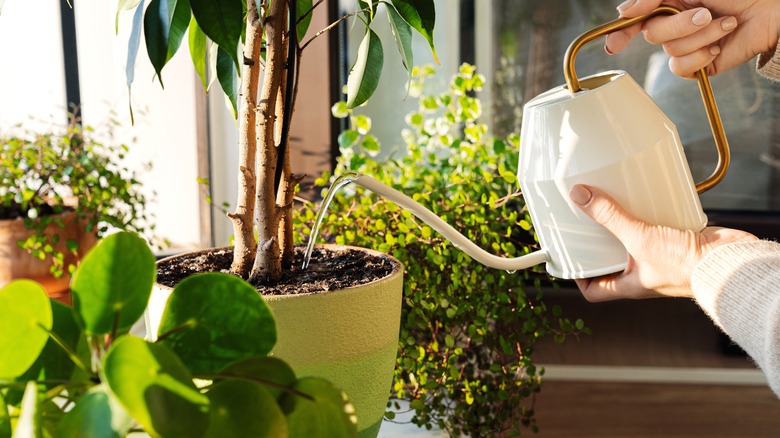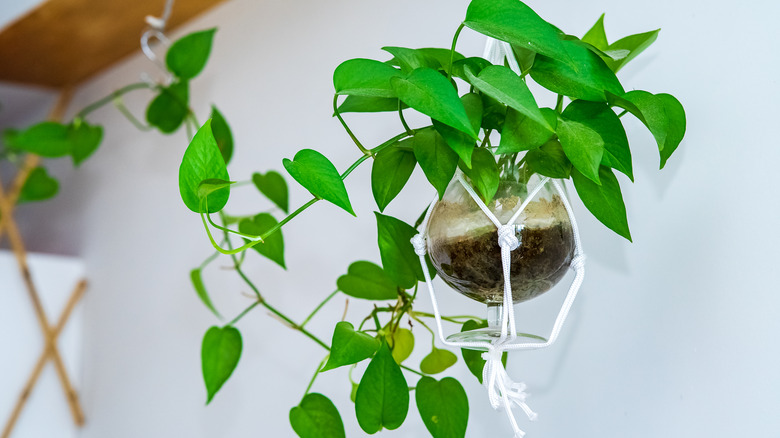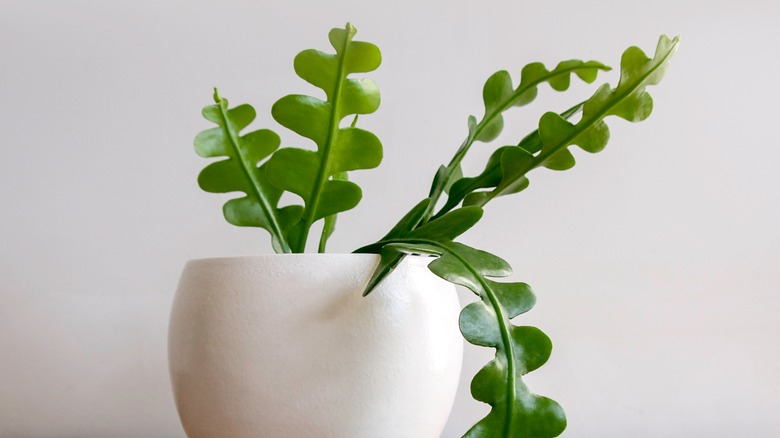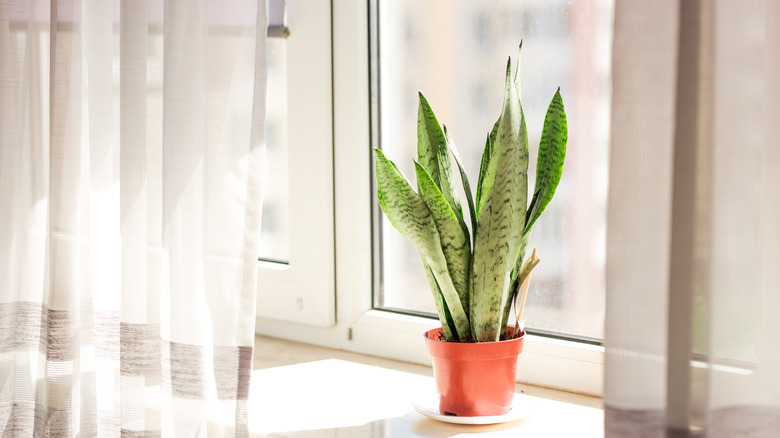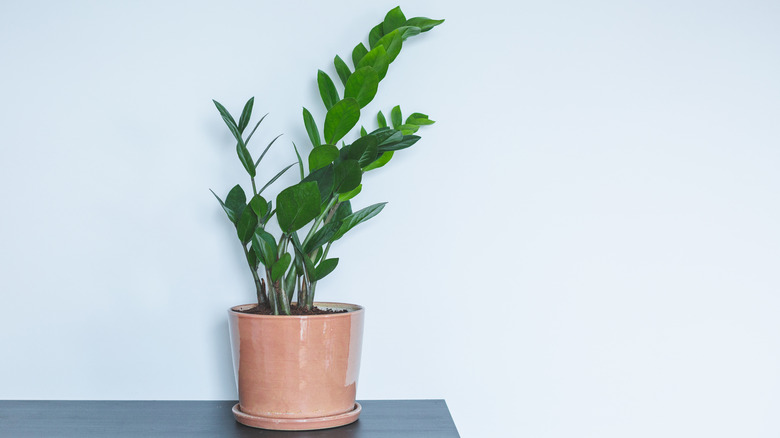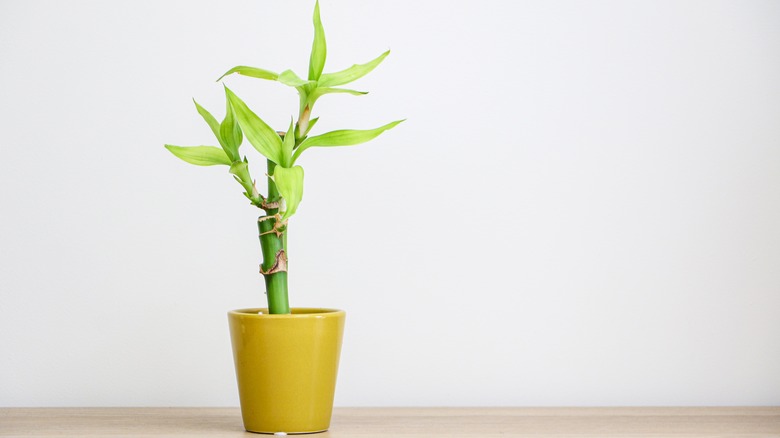5 Easy-To-Grow Plants That Are Perfect For Your Dorm Room
If you live in a dorm room, you're probably at the point in the semester when you are mostly settled into your space and routine. Your boxes are unpacked, the walls are donned with posters repping your favorite band, and your bed is dressed in the best set of twin XL sheets that you could find. Yet, even with all of those things in place, your dorm room is probably still looking a little bit stale and lifeless. The best remedy? Plants! A drab dorm room quickly becomes a calm and homey dwelling with a few green-leafed friends.
Luckily, there are plenty of houseplants adapted to the unique conditions often presented by dorm life: low light, tight quarters, and a busy schedule full of matters more pressing than watering fussy plants. Adding live greenery to your dorm room will beautify your space and make you a better student because, according to Healthline, the presence of indoor plants can reduce stress and improve focus, productivity, and air quality. Below, we've rounded up our five favorite contenders that fit the bill, but there are tons of low-maintenance houseplants out there.
1. Pothos
Pothos, or Epipremnum aureum, is a houseplant that is popular for being extremely easy to care for. Plus, as a climbing plant, its long tendrils are easy to prop up along the wall, creating a sort of living wall décor garland. According to The Sill, the most common pothos cultivar comes in a jade green shade, but there are other varieties out there, including the golden pothos with its yellow heart-shaped leaves and the coveted pothos marble queen, which features deep green and white marbling on its leaves. Sometimes called devil's ivy, all pothos cultivars feature glossy pointed leaves that measure 4 to 8 inches. Indoors, the cascading vines of a pothos plant can grow up to 10 feet long.
To care for your pothos, place it somewhere with indirect sunlight. Bright light is best, but it is known to survive low light settings as well. Just don't give it a lot of direct sunlight, or the pothos will burn and turn brown. As far as watering goes, this plant just needs to be watered when its soil is dried out–usually, every one to two weeks, depending on how much sunlight it gets. If it gets too much water, the leaves will turn yellow; if it's too dry, they will wilt.
2. Fishbone cactus
If you prefer to go in a unique direction, consider getting a fishbone cactus (Epiphyllum anguliger) for your dorm room. This eye-catching plant doesn't need as much sun as most cacti, making it a great option for spaces with lower light. Native to Mexico, the fishbone cactus is identifiable by its zig-zag-shaped stems. In fact, it is often referred to as zig-zag cactus. You might also find it by the name ricrac cactus or orchid cactus.
When choosing a home for it, try for a spot that receives bright indirect light. According to Mod and Mint, leaves turning red or dry and brown spots mean your zig-zag plant is getting too much direct light. If your dorm doesn't get much sun, the fishbone cactus will still do okay, but its stems may have a less defined zig-zag pattern as they stretch to try to find more light. On the flip side, this plant needs to be watered more than most cacti. Give it some water when the top of its soil is dry. If your plant becomes limp and wrinkled, it's thirsty; if it turns yellow, it has been overwatered, so let it dry out and go without water for a while.
3. Snake plant
Dracaena trifasciata, known commonly as snake plant or mother-in-law's tongue, is another easy-to-care-for houseplant that is a great option for dorm rooms. It features rigid, pointed leaves, earning it the nickname St. George's sword. According to Almanac, the only real way to mess up this practically indestructible plant is by overwatering it or exposing it to freezing temperatures. To avoid this, keep it away from drafty windows in the winter and make sure that it's potted in a vessel with a drainage hole at the bottom. Give it well-draining soil, preferably a mix designed for cacti and succulents.
The snake plant is really flexible about the type of sunlight it receives and how much. In an ideal world, it prefers bright indirect light but will also tolerate some direct sunlight and low light conditions. As far as watering goes, you can hold off until its soil is completely dried out. Stick your finger into the soil a few inches and hold off on watering if you feel any moisture. Watering snake plants from the bottom of their pots stimulates strong root growth.
4. ZZ plant
Zamioculcas zamiifolia, commonly called the ZZ plant, is a hardy, drought-resistant houseplant that hails from Africa. Known for its strikingly shiny dark green ovoid leaves, the ZZ plant is popular in homes and offices due to its tolerance for low light conditions and easy-breezy watering schedule, making it a perfect dorm room greenery.
According to the University of Florida, you should use well-draining potting soil composed mainly of peat or bark for this plant. Allow the soil to completely dry out in between waterings, making sure that your leafy companion is never sitting in water for an extended period, or it may develop root rot. If you forget to give it to drink for a while, odds are this resilient greenery will be just fine. The ZZ plant is toxic to humans and animals if ingested, however, so it may not be the best option if you have a pet that likes to munch on leaves.
5. Lucky bamboo
Lucky bamboo, classified under the scientific name Dracaena sanderiana, is actually not bamboo at all and is more closely related to succulents, according to Almanac. However, this African-native cultivar bears a close resemblance to its namesake and is regarded for its low maintenance care needs and for bringing good luck, making it the perfect plant for your dorm room. Often used in the practice of feng shui, lucky bamboo can be grown in either soil or water.
The plant loves bright, indirect sunlight if you can provide it. If you choose to grow it in soil, use a well-draining potting mix for your lucky bamboo and keep it moist (not wet). If you choose to keep your lucky bamboo in water, fill a container with pebbles and enough water to submerge the plant's roots. Filtered water is ideal, but you can also let tap water sit out for 24 hours to allow the chlorine to evaporate. Then, keep giving it to drink to maintain its level above the roots and change the water completely every 7 to 10 days to avoid bacterial growth.
